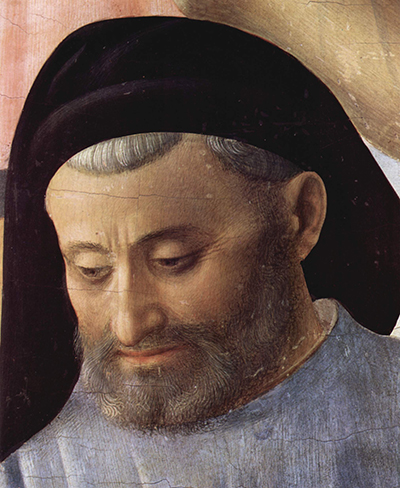Fra Angelico was a highly skilled member of the early Italian Renaissance whose contribution was significant in the development towards the later work of the likes of Michelangelo and Raphael
Fra Angelico translates as Angelic friar and is one of various names used to identify this talented painter. His own contempories would refer to him as either Fra Giovanni da Fiesole (Brother John of Fiesole) or Fra Giovanni Angelico (Angelic Brother John) but the anglicised name of Fra Angelico has been much more commonly used in recent centuries. Some Italians, however, may refer to him as Beato Angelico (Blessed Angelic One) instead.
The extraordinary skills of the Renaissance were carefully handed down from generation to generation, normally from teacher to pupil in one of the many art studios in the Papal States. The more famous names would receive a constant supply of commissions and for many there would be a need for assistance from their studio. In order to ensure that the artist's own reputation was not jeopardised, they would put plenty of time into training up their young apprentices. Fra Angelico would teach Benozzo Gozzoli, for example, whilst Michelangelo learnt his trade under the guidance of Domenico Ghirlandaio.
The early renaissance was a notoriously intentive age where painting was starting to push into new directions. Previous to Fra Angelico was Giotto di Bondone who had started this transition and continues to inspire new artists even in the present day.
The artist was born in the village of Rupecanina which is close to Fiesole, a picturesque town that sits close to Florence. Tuscany was one of the key regions in the Italian Renaissance and would provide this young man with all the opportunities that he needed to thrive. Unlike many other artists of this time Fra Angelico had no parental link to the art world, as far as we know, but his brother Benedetto worked as an illuminator.
It was his brother who helped him to get his earliest training as they worked alongside each other. They would live in several different convents and were highly religious, which can be seen in his own paintings. Fra Angelico's earliest work is documented as having been an altarpiece and painted screen for the Charterhouse (Carthusian monastery) in Florence, but little information remains on this work today.
Much of his early work was lost or damaged beyond repair including most of his paintings produced between 1408 and 1436. During this time he could be found in Cortona and then in another convent in Fiesole. The National Gallery in London hosts one of the few remaining items from this period, a predella section designed for an altarpiece commission. Hundreds of figures can be found in this detailed composition.
By 1436 it was time for Fra Angelico to really start to make his mark on the art world. He would move with several colleagues to a new convent in a more central part of Florence. He was now ideally located to both promote his own work but also absorb the best of others. Art was much more localised during this period, with painters rarely going beyond the boundaries of their state or country. Artistic literature would also have been far more scarce than it is now, so those looking to bring new ideas into their work would have to be willing to find their nearest artistic community.
Fra Angelico would be tasked initially with decorating his new home, providing several frescoes for the Chapter House, possibly after the intervention of Cosimo de' Medici. These artworks would teach of devotion and the importance of continuing to follow the teachings of God. Various events in the life of Christ were used as inspiration for much of this work, just as many other Renaissance artists would do at this time.
Fra Angelico would start to produce sacred conversations, where saints would be placed in a more natural setting, as if chatting to each other. This brought normal life and the heavenly closer together than had been seen by most other artists. The likes of Giovanni Bellini, Perugino and Raphael would pick up regular commissioned paintings that made use of this artistic style.
Our young tuscan would have been inspired by Gentile's altarpiece of the Adoration of the Magi which stood in the Uffizi and showed the young artist the way ahead. Masaccio was also around at this time and had studied in depth the work of Giotto, incorporating some of his ideas and techniques into his own work. The work of Gentile is considered by many to be amongst the highlights from the entire Gothic art movement.
Whilst achieving great success within his career and building an impressive reputation and a host of high profile contacts, Fra Angelico would never lose his kind, modest personality and also continued to retain his close affinity for the Church. In his later yeats he would return to his old stomping ground at the convent of Fiesole and whilst here he served as the prior.




